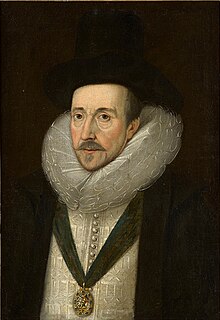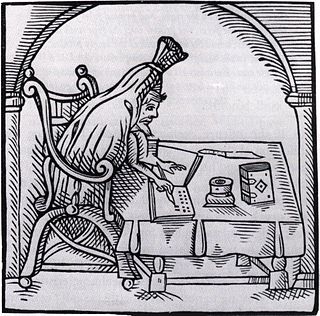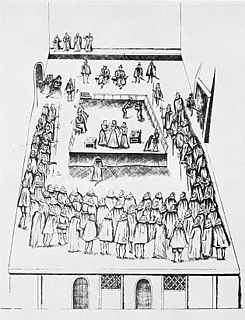Works
Harvey's first book An Astrological Discourse (1583) made some stir. In it he defended judicial astrology, replying to his brother Gabriel., [2] and gave a weather forecast for Sunday, 28 April 1583 of a great wind presaging further apocalyptic events. Harvey was here drawing on Cyprian Leowicz and Regiomontanus. [1] With it Harvey printed A Compendious Table of Phlebotomie or Bloudletting, of eight pages, containing an "auncient commendation" of phlebotomy. The prediction failed, and Harvey was ridiculed. He was mocked in the tripos verses at Cambridge, as his brother Gabriel's enemy Thomas Nashe, reported, by the comic actor Richard Tarleton, and by the ballad writer William Elderton. Thomas Heth wrote a reply. [2]
In 1590 Harvey published A Theologicall Discovrse of the Lamb of God and his enemies with a dedication to Robert Devereux, 2nd Earl of Essex, The work comprised the substance of sermons which, according to Nashe, had been preached three years earlier. Harvey wrote that the book explained his attitude to the Martin Mar-Prelate controversy. He steered a middle line between the bishops and their opponents, and criticised "poets and writers, who had taken part in the dispute". An anonymous tract Plaine Percevall, the Peacemaker of England, sweetly indevoring with his blunt persuasions to botch up a reconciliation betwixt Mart-on and Mart-other (1590?) supported the Puritan side of the controversy, and made contemptuous mention of the tract entitled The Pappe with a Hatchet ascribed to John Lyly. [2]
Harvey's abuse of men of letters stirred Robert Greene to the attack on Harvey and his brothers Gabriel and John, A Quippe for an Upstart Courtier (1592, not extant). In the literary quarrel which followed between Gabriel Harvey and Nashe, Greene's champion Nashe parodied Richard's Astrological Discourse of 1583 in A Wonderfull, strange, and miraculous Astrologicall Prognostication, 1592. In his Strange Newes of the Intercepting of certain Letters, 1592, Nashe spoke of Richard as "a notable ruffian with his pen". According to Nashe, Harvey lost his benefice through incompetency, and eloped with and married a daughter of Thomas Mead the judge. He may have gone blind, as Nashe alleged. [1] [2]
Publications: [2]
- Mercurius sive lachrymæ in obitum D. Thomæ Smith (printed at the end of Gabriel Harvey's Smithus, 1578).
- An Astrological Discourse upon the great and notable Conjunction of two Superiour Planets, Saturne and Jupiter, which shall happen on the 28 day of April 1583 … with a briefe Declaration of the Effectes which the late Eclipse of the Sunne 1582 is yet hereafter to woorke: written newly by R. H. London, 1583 (two editions), dedicated to John Aylmer, bishop of London.
- Ephemeron sive Pæana: in gratiam propurgatæ reformatæque dialecticæ, London, 1583, dedicated to the Earl of Essex, a Ramist work. [1]
- A Theologicall Discovrse of the Lamb of God and his enemies, 1590.
- Philadelphus, or a Defence of Brutes and the Brutans History, London (by Iohn Wolfe), 1593, dedicated to the Earl of Essex, in which George Buchanan is addressed. It contains the first known use of the word "Anthropology" in English: "Genealogy or issue which they had, Artes which they studied, Actes which they did. This part of History is named Anthropology."
Barnabe Barnes was an English poet. He is known for his Petrarchan love sonnets and for his combative personality, involving feuds with other writers and culminating in an alleged attempted murder.

Thomas Nashe was an Elizabethan playwright, poet, satirist and a significant pamphleteer. He is known for his novel The Unfortunate Traveller, his pamphlets including Pierce Penniless, and his numerous defences of the Church of England.

John Lyly was an English writer, dramatist, courtier, and parliamentarian. He was best known during his lifetime for his two books Euphues: The Anatomy of Wit (1578) and its sequel Euphues and His England (1580), but perhaps best remembered now for his plays. Lyly's distinctive and much imitated literary style, named after the title character of his two books, is known as euphuism.

Gabriel Harvey was an English writer. Harvey was a notable scholar, whose reputation suffered from his quarrel with Thomas Nashe. Henry Morley, writing in the Fortnightly Review, has argued that Harvey's Latin works demonstrate that he was distinguished by qualities very different from the pedantry and conceit usually associated with his name.
Abraham Fraunce was an English poet.

Henry Howard, 1st Earl of Northampton KG was an important English aristocrat and courtier. He was suspect as a crypto-Catholic throughout his life, and went through periods of royal disfavour, in which his reputation suffered greatly. He was distinguished for learning, artistic culture and his public charities. He built Northumberland House in London and superintended the construction of the fine house of Audley End. He founded and planned several hospitals. Francis Bacon included three of his sayings in his Apophthegms, and chose him as "the learnedest councillor in the kingdom to present to the king his Advancement of Learning." After his death, it was discovered that he had been involved in the murder of Sir Thomas Overbury.

Gervase Babington (1549/1550–1610) was an English churchman, serving as the Bishop of Llandaff (1591–1594), Bishop of Exeter (1594–1597) and Bishop of Worcester in 1597–1610. He was a member of the Babington family and held influential offices at the same time as his cousin Anthony Babington was executed for treason against Elizabeth I as part of the Babington Plot.

Simon Forman was an Elizabethan astrologer, occultist and herbalist active in London during the reigns of Queen Elizabeth I and James I of England. His reputation, however, was severely tarnished after his death when he was implicated in the plot to kill Sir Thomas Overbury. Astrologers continued to revere him, while writers from Ben Jonson to Nathaniel Hawthorne came to characterize him as either a fool or an evil magician in league with the Devil.

John Casimir, Count Palatine of Simmern was a German prince and a younger son of Frederick III, Elector Palatine. A firm Calvinist, he was a leader of mercenary troops in the religious wars of the time, including the Dutch Revolt. From 1583–1592 he acted as regent for his nephew, Elector Palatine Frederick IV.
Peter Osborne, Esquire, (1521–1592) was Keeper of the Privy Purse to King Edward VI, at a time when great constitutional changes affected the management of public finance. Of reformist sympathies in religion, his career was in abeyance during the reign of Queen Mary but regained momentum as Remembrancer in the Exchequer under Elizabeth, working usually to his marital kinsman Lord Burghley, and he sat in seven parliaments between 1559 and 1589.
Sir Christopher Heydon was an English soldier, Member of Parliament, and writer on astrology. He quarrelled with his family over its estates in Norfolk.

Robert Greene (1558–1592) was an English author popular in his day, and now best known for a posthumous pamphlet attributed to him, Greene's Groats-Worth of Witte, bought with a million of Repentance, widely believed to contain an attack on William Shakespeare. Robert Greene was a popular Elizabethan dramatist and pamphleteer known for his negative critiques of his colleagues. He is said to have been born in Norwich. He attended Cambridge where he received a BA in 1580, and an M.A. in 1583 before moving to London, where he arguably became the first professional author in England. Greene was prolific and published in many genres including romances, plays and autobiography.
Events from the 1590s in England.
Arthur Yeldard (c.1530–1599) was an English clergyman and academic, chosen as the first Fellow and second President of Trinity College, Oxford.
Richard Forster (c.1546–1616) was an English physician.
John Stockwood was an English clergyman, preacher, translator of Protestant texts and school-master.

Robert Beale was an English diplomat, administrator, and antiquary in the reign of Elizabeth I. As Clerk of the Privy Council, Beale wrote the official record of the execution of Mary, Queen of Scots, to which he was an eyewitness.
John Harvey (1564–1592) was an English astrologer and physician.

Pierce Penniless, His Supplication to the Divell is a tall tale, or a prose satire, written by Thomas Nashe and published in London in 1592. It was among the most popular of the Elizabethan pamphlets. It was reprinted in 1593 and 1595, and in 1594 was translated into French. It is written from the point of view of Pierce, a man who has not met with good fortune, who now bitterly complains of the world’s wickedness, and addresses his complaints to the devil. At times the identity of Pierce seems to conflate with Nashe's own. But Nashe also portrays Pierce as something of an arrogant and prodigal fool. The story is told in a style that is complex, witty, fulminating, extemporaneous, digressive, anecdotal, filled with wicked descriptions, and peppered with newly minted words and Latin phrases. The satire can be mocking and bitingly sharp, and at times Nashe’s style seems to relish its own obscurity.
Robert Harrison was an English lay schoolmaster who became a religious leader as a Protestant Separatist, one of the original Brownists.
![]() This article incorporates text from a publication now in the public domain : Stephen, Leslie; Lee, Sidney, eds. (1891). "Harvey, Richard". Dictionary of National Biography . Vol. 25. London: Smith, Elder & Co.
This article incorporates text from a publication now in the public domain : Stephen, Leslie; Lee, Sidney, eds. (1891). "Harvey, Richard". Dictionary of National Biography . Vol. 25. London: Smith, Elder & Co.








